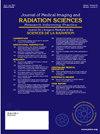Assessment of Stroke Onset Time Based on DINOv2 Visual Features
IF 1.3
Q3 RADIOLOGY, NUCLEAR MEDICINE & MEDICAL IMAGING
Journal of Medical Imaging and Radiation Sciences
Pub Date : 2024-10-01
DOI:10.1016/j.jmir.2024.101479
引用次数: 0
Abstract
Background
Currently, the thrombolytic treatment for acute ischemic stroke (AIS) strictly depends on the time since stroke onset (TSS) being less than 4.5 hours. However, some patients are excluded from thrombolytic treatment due to uncertain TSS. Clinically, diffusion-weighted imaging (DWI) and fluid-attenuated inversion recovery (FLAIR) mismatch are commonly used to roughly determine TSS.
Methods
In this paper, we propose a method based on DINOv2 to classify the TSS as less than or more than 4.5 hours. We conducted model training and external testing using case data from two hospitals. These hospitals respectively included 226 and 85 cases of TSS less than 4.5 hours, along with an equal number of cases with TSS greater than 4.5 hours. Firstly, we utilized DINOv2 for automatic segmentation of lesions and extraction of visual features from DWI and FLAIR images. Then, the visual features of the lesion area were input into four different machine learning models. Finally, a conclusion on whether the patient's onset time is more or less than 4.5 hours is reached through a weighted voting method.
Results
The results from the external test set show that in lesion segmentation from DWI and FLAIR images, the Dice coefficients were as high as 0.872 and 0.823, respectively. In the judgment of TTS less than 4.5 hours, our approach achieved an accuracy of 0.865, sensitivity of 0.843, and specificity of 0.902.
Conclusion
The assessment of TTS based on DINOv2 visual features demonstrates excellent performance. The results of this approach significantly surpass those of human doctors using the DWI-FLAIR mismatch method. Moreover, it achieves a fully automated process for rapid and efficient handling. This approach is expected to play a key role in treatment decision-making for patients with unknown TSS.
基于 DINOv2 视觉特征的卒中发病时间评估
背景目前,急性缺血性卒中(AIS)的溶栓治疗严格依赖于卒中发生时间(TSS)小于 4.5 小时。然而,一些患者因 TSS 不确定而被排除在溶栓治疗之外。在临床上,弥散加权成像(DWI)和液体增强反转恢复(FLAIR)错配常用于粗略判断 TSS。方法在本文中,我们提出了一种基于 DINOv2 的方法,将 TSS 分为小于或大于 4.5 小时。我们使用两家医院的病例数据进行了模型训练和外部测试。这两家医院分别有 226 例和 85 例 TSS 小于 4.5 小时的病例,以及同等数量的 TSS 大于 4.5 小时的病例。首先,我们利用 DINOv2 自动分割病灶,并从 DWI 和 FLAIR 图像中提取视觉特征。然后,将病变区域的视觉特征输入四个不同的机器学习模型。结果外部测试集的结果显示,在从 DWI 和 FLAIR 图像进行病灶分割时,Dice 系数分别高达 0.872 和 0.823。结论基于 DINOv2 视觉特征的 TTS 评估表现出色。这种方法的结果大大超过了使用 DWI-FLAIR 不匹配方法的人类医生的结果。此外,它还实现了快速高效处理的全自动流程。这种方法有望在未知 TSS 患者的治疗决策中发挥关键作用。
本文章由计算机程序翻译,如有差异,请以英文原文为准。
求助全文
约1分钟内获得全文
求助全文
来源期刊

Journal of Medical Imaging and Radiation Sciences
RADIOLOGY, NUCLEAR MEDICINE & MEDICAL IMAGING-
CiteScore
2.30
自引率
11.10%
发文量
231
审稿时长
53 days
期刊介绍:
Journal of Medical Imaging and Radiation Sciences is the official peer-reviewed journal of the Canadian Association of Medical Radiation Technologists. This journal is published four times a year and is circulated to approximately 11,000 medical radiation technologists, libraries and radiology departments throughout Canada, the United States and overseas. The Journal publishes articles on recent research, new technology and techniques, professional practices, technologists viewpoints as well as relevant book reviews.
 求助内容:
求助内容: 应助结果提醒方式:
应助结果提醒方式:


